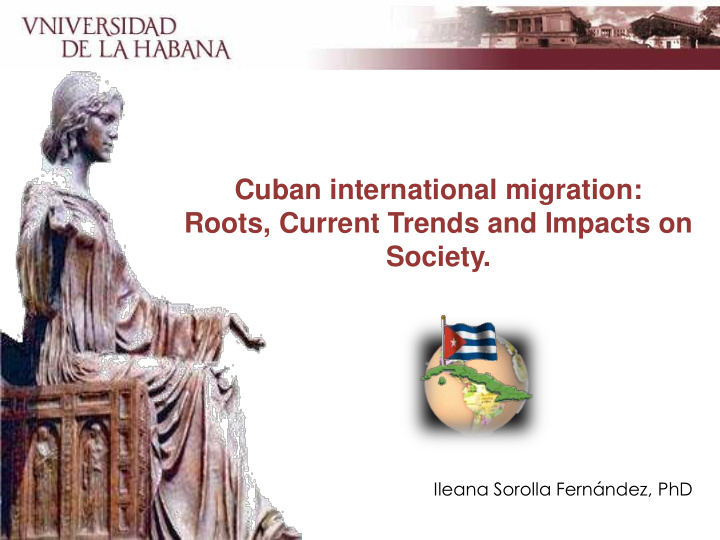



Cuban international migration: Roots, Current Trends and Impacts on Society. Ileana Sorolla Fernández, PhD
St. Christopher of Havana : the migrant city Founded in 1514 on the south coast, on the shores of the Gulf of Batabano. In 1517 the city was moved to its current location, settled around the Triscornia bay, on the north coast of the Island.
Who are Cuban Migrants? ≈ 20% of the population living abroad Age and sex: Young migration, mostly female. 53,2% of the migrant are women under 30 years. Median age - 26,2 years Educational level: Secondary - 40,8%, High school - 35,1% Higher Education degree - 23,9%
Where are they from?
Where do they migrate?
Current trends on Cuban International Migration “Being and belonging to two or more societies at the same time” • A Shift of Cuban migration from EMIGRATION to MOBILITY and SAFE TEMPORARY MIGRATION . • Put down roots in a host country (Integration), but maintain strong homeland ties (Transnationalism). • The migration management initiatives: unsuccessful, because of lack of bilateral inter-state cooperation .
Current trends on Cuban International Migration • Remittances: send money back, but cultural remittances too! • People who stay behind are connected to migrants through the networks of social relations they sustain across borders, so they are exposed to a constant flow of economic and social remittances (ideas, practices, and identities that migrants import) • Increasing family expectations on communications and visits . • Return to live/participate in the home country .
Impact of Cuban Migration on Society: • The impact of emigration on cuban economy and development conditions. • The qualification of migrants. • Population and family impacts: aging of cuban society. • Selectivity of immigration policy of the main receiving countries. • The transnational practices and its potencial influence on emigration expectations and projects.
• Consider the multiple layers of transnational social fields, not only their multiple sites. • Expectation that social life takes place within the nation-state framework no longer corresponds to the reality. • Put the scope on those who migrate, but at the same time to those who do not actually move. It requires: New methodology and conceptual tools, academic collaboration, New policy responses, a comprehensive and sustainable cooperation between governments, Transnational social support.
Cuban international migration: Roots, Current Trends and Impacts on Society . Ileana Sorolla Fernández, PhD
Recommend
More recommend